Copyright 2020 - 2021 irantour.tours all right reserved
Designed by Behsazanhost
The World's Most Beautiful Jewels Museum
Treasury of the National Jewels
The incomparable "Treasury of the National Jewels", which is open to the public, is a collection of the most expensive jewels in the world, collected over centuries. Every piece of this collection is a reflection of the tumultuous history of this great nation, and the result of the creativity and artistry of the residents of this land. Each piece recalls memories of bitter-sweet victories and defeats, of the pride and arrogance of rulers who were powerful or weak.
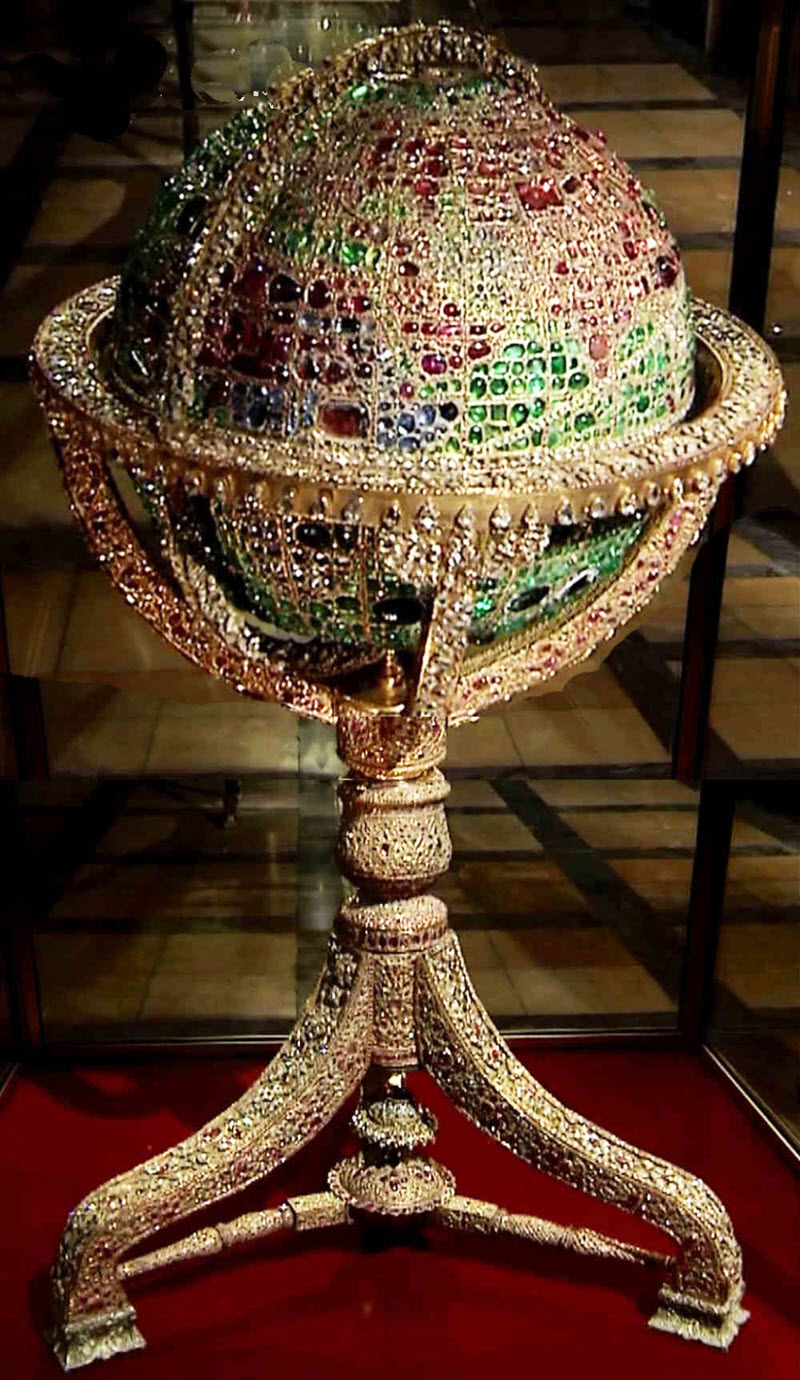 |
Dear viewers, who have come to see the excellent work and the gems of this unique collection. Before you are overwhelmed by its glitter, consider the historical reasons for collecting these jewels. Recognize the judgment of history, and with
Our intention in presenting these jewels is to get you more acquainted with the rich culture and civilization of Iran and to learn from history the fate of those who pursue power and hoard wealth. To this end, we present this rich collection, which we have inherited and hope to preserve and pass on to our inheritors.
The value of the objects in the Treasury of National Jewels is not limited to their economic value, but is also a reflection of the creativity and taste of Iranian craftsmen and artists over the different eras of history, and represents the artistic and cultural heritage of the vast country of Iran. These jewels and rarities were decorations for the rulers during the past eras and often showed the glory and extravagance of their courts, as well as their power and wealth. There is no information about the quality and quantity of the treasuries before the Safavid period. It can be said that the recorded history of the Treasury of Jewels began with the Safavid monarchs. In short, the history of the amassment of the present collection is as follows:
Before the Safavid dynasty, certain jewels existed in the government treasuries, but it was with the Safavid dynasty that foreign travelers (Jean-Baptiste Tavernier, Chevalier Chardin, the Shirley brothers, George Mainwaring, and others) began to mention these treasuries. The Safavid monarchs, over two centuries (907 to 1148 LH * equal to about 1502 to 1735 AD), started to collect rare and beautiful gems. The gem specialists of the Safavid court brought fine stones to Isfahan, the capital of Iran at that time from the markets of India, the Ottoman Empire, and European countries like France and Italy.
After the rule of Shah Soltan Hossein and the entry of Mahmoud the Afghan to Iran, the treasury was scattered, and some of the jewels were taken by Mahmoud the Afghan and transferred to Ashraf the Afghan. After the entry of Shah Tahmaseb ll and Nadir to Isfahan, these jewels fell into the hands of Nadir and thus were preserved inside the country. Later, in order to regain the jewels that had been transported to India, Nadir wrote several letters to the Indian court but did not receive any favorable reply. After Nadir's victory in India in 1158 LH (1745 AD), Mohammed Shah delivered cash amounts, jewels, and weapons to Nadir as booty. Part of the treasures that were obtained in India never reached Iran and were lost during transportation. According to the tradition of that time, after returning to Iran, Nadir sent part of the booty as gifts to neighboring rulers. He also presented some beautiful and rare objects to the Holy Shrine of Imam Reza, while some were distributed among the soldiers of his army.
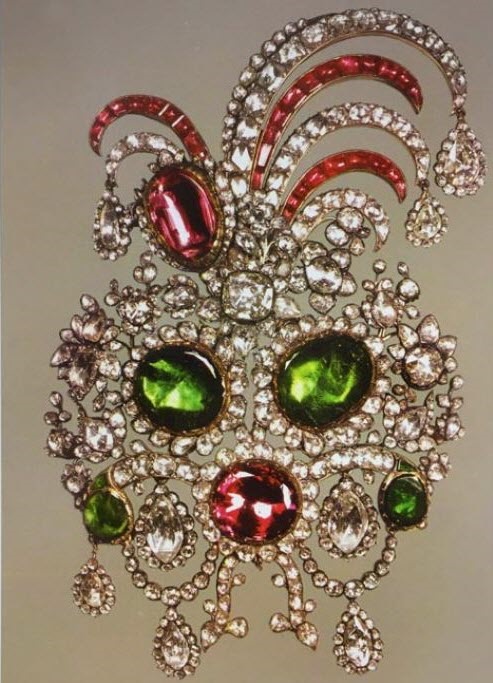 |
After the assassination of Nadir in 1160 LH (1747 AD), Ahmad Beg Afghan Abdali, one of his commanders, looted his treasury of Nadir. One of the famous jewels that left Iran at this time and never returned was the famous "Kooh-e-Nur" (Mountain of Light) diamond. This diamond was passed on to the hands of Ahmed Shah Durrani and then to Ranjit Singh of Punjab. After his defeat by the British government, the Kooh-e-Nur diamond fell into the hands of the East India Company, and in 1266 LH (1850 AD) it was given to Queen Victoria as a gift.
After this event, there was no major change in the Treasury until the time of the Qajar dynasty. During the Qajar period, the Treasury was collected and recorded. Some of the stones were mounted on the Kiani Crown, the Nadir Throne, the Globe of Jewels, and the Peacock Throne (or the Sun Throne). Two other items that were gradually added to this Treasury, are the turquoises, the genuine precious stone of Iran, extracted from the local turquoise mines, and the other is pearls, hunted from the Persian Gulf.
According to the law approved on 25th Aban 1316 SH* (1937 AD) a major portion of the Treasury was transferred to Bank Melli Iran and formed part of the reserves for note issues, and later became collateral for government liabilities to the Bank. The present collection was constructed in 1334 SH (1955 AD). In 1339 SH (1960 AD). by the establishment of Bank Markazi Iran, ** the Treasury was transferred and deposited with the Central Bank. Now it is also safeguarded by Bank Markazi Jomhouri Islami Iran.
During the glorious Islamic Revolution of Iran and the imposed war, this precious and peerless collection was protected by the devoted and revolutionary employees of Bank Markazi Jomhouri Islami Iran. Now, you visit a unique collection of precious stones, that have been gathered over turbulent eras. It is hoped that by viewing these objects and remembering the Almighty God, you will see the finite place of humans in the vast world, and recognize that the place of crowns and tiaras is in a museum --- which shows a bloody and painful history -- a history that should under no circumstances be repeated again. However, much can be said about this fantastic collection, but one question cannot correctly be answered:
How much is the value of this collection?
No one knows the answer to this question. Because this collection contains gems that are unique in the world. The answer to this question can be the following: From the artistic viewpoint, historical background, and incomparable jewels, the Treasury of National Jewels is on a level that even the most expert evaluators of the world have not been able to calculate the price of this collection.
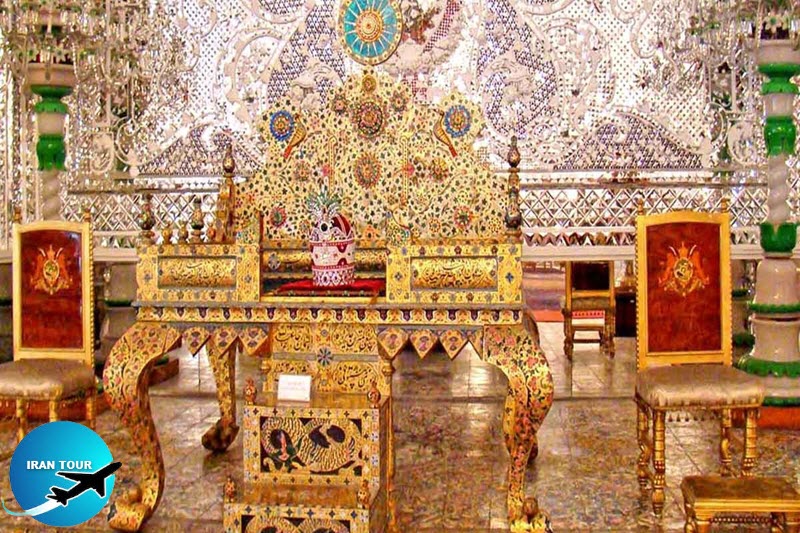 |
Nadir Throne
Nadir Throne Historians believe that Nadir Shah, upon his return from India in the year 1739-1740, brought nine jeweled thrones in addition to the Peacock Throne to Iran. It is further reported by Malcolm (History of Persia, Vol. II, p. 37) that Nadir Shah was so fond of the famous Peacock Throne of the Great Moguls that he had an exact duplicate of it made in other jewels. However, today there is no trace of any of these thrones. Historians unanimously mention that all were destroyed after the death of Nadir Shah in 1747 AD. The present throne, although named after Nadir, has no relationship to him whatsoever. There is persuasive evidence that it was constructed during the reign of Fath-Ali Shah (1798-1834 AD). The panels, located around the seat of the throne, contain inscriptions that attribute the construction of this throne to Fath-Ali Shah. The motive of Fath-Ali Shah in having this throne made, was to display the pomp and splendor of his court to his subjects, as well as, to foreign envoys who visited the king in various summer residences around Tehran. For this purpose, this throne is composed of 12 separate and portable parts. The total number of precious stones set on the throne amounts to 26,733. This throne was used in the coronation ceremony of Mohammad Reza Pahlavi.
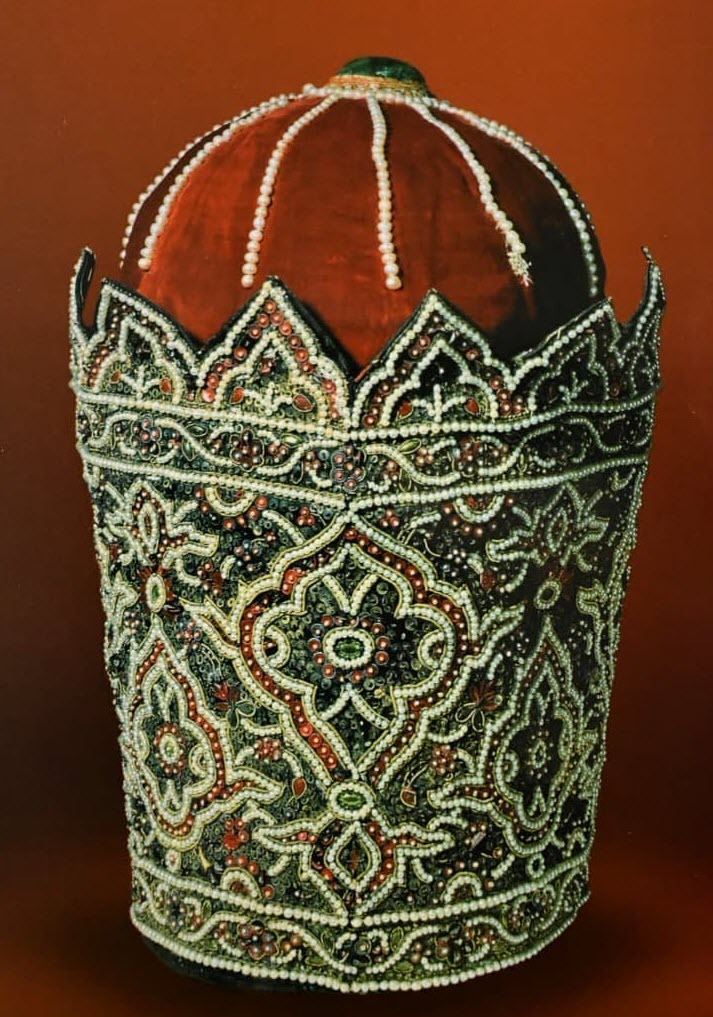 |
Abbas Mirza hat
The other case contains the hat of Abbas Mirza, garments of the Qajar period, a robe of gold, pearls, and bead embroidery (Item 6), and other objects. The hat of Abbas Mirza, in the shape of a crown, is made of red satin and velvet cloth that has been sown with pearls and gold sequins. On top is a large emerald set with diamonds. This hat was used by Abbas Mirza, Crown Prince of Fath-Ali Shah, on official occasions.
Objects Assigned for the Use of Farah Pahlavi
Item 1: Platinum necklace set with 10 large emeralds, 486 diamonds, and 4 huge pearls (two of these pearls. each have 29 millimeters in length). The necklace was made for the coronation ceremony in 1967 AD.
Item 2: Platinum tiara set with 324 diamonds. The 60-carat pale pink diamond known as "Nur
Item 4: Platinum earrings set with small diamonds and two strawberry-shaped emeralds. (1938 AD)
Item 5: Platinum earring set with diamonds and emeralds. The two 70-carat
Item 6: Platinum earrings set with 4 emeralds, and 48 diamonds. (Made for the coronation ceremony in 1967 AD).
Item 8: Platinum tiara set with 676 diamonds. (1938 AD)
Item 13: Tiara set with 200 diamonds and 20 emeralds (1938 AD). Item 14: Tiara set with 294 diamonds and 7 huge emeralds. (1958 AD)
Item 15:
Item 19:
A necklace set with diamonds and emeralds known as the necklace of Qamar-
Ring set with an emerald of 24.60 carats in a bezel of diamonds. Platinum necklace set with 294 diamonds and one enormous emerald
Necklace with three rows of pearls. In 1938 AD, it was made with 143 pearls, and in 1958 AD, remodeled with 169 pearls.
Necklace of gold set with diamonds and spinels.
The necklace is composed of two rows of pearls comprising a total of 247 pearls. (1970 AD).
 |
Farah Pahlavi Crown
Crown used by Farah Pahlavi. The crown has been made using selected gems from the Treasury, by Van Cleef et Arpels in 1967.
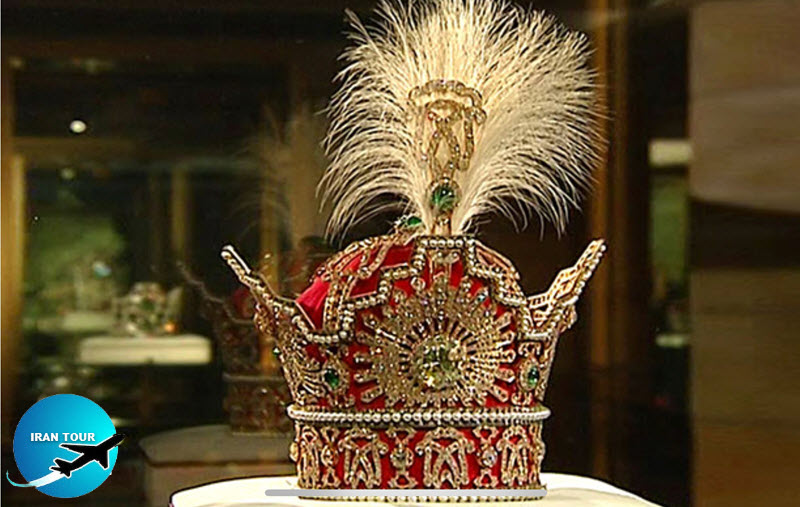 |
Reza Khan and Mohammad Reza Pahlavi Crown
Crown used by Reza Khan and Mohammad Reza Pahlavi. This crown is made of gold and silver and decorated with diamonds, emeralds, sapphires,
The crown used during the coronation of the Qajar Kings was the Kiani Crown, but Reza Khan Pahlavi was not inclined to use it. In 1925 AD, a group of Iranian jewelers, under the supervision of Haj Serajeddin (the famous jeweler who had been a jeweler to the Amir of Bokhara, and had emigrated from Russia to Iran), undertook to make this crown, using selected stones from the Treasury. This crown was used in the coronation of Reza Pahlavi. held on April 25, 1926 AD, and in the coronation of Mohammad Reza Pahlavi on October 26, 1967 AD.
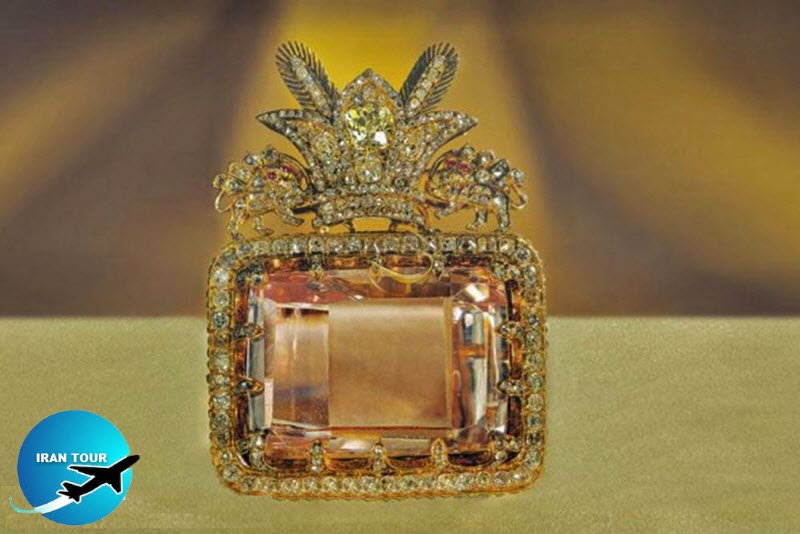 |
Darya-i-Nur or Sea of Light
The famous Darya-i-Nur or Sea of Light is the largest pink! diamond of the world and takes first place among the diamonds in the National Treasury of Iran. This famous diamond along with its mate, the Kooh-i-Nur, or Mountain of Light, perhaps due to the similarity of names, has always come together in history, although there is no similarity in cut or color between these two diamonds. Both of these stones were in the possession of Nadir Shah. After his death, Ahmad Shah Durrani took Kooh-i-Nur to Afghanistan. After Ahmad Shah, it passed on to Shah Shuja, and after the defeat of Shah Shuja by Ranjit Singh the Lion of Punjab, it passed into his possession. Later East India Company obtained it and presented it as a gift to Queen Victoria. It is presently in the Queen Mother's Crown in England. The Darya-i-Nur diamond was inherited by Shahrokh Mirza, the grandson of Nadir Shah. It then came into the possession of Amir Alam Khan Khozeimeh, and later, Lotfali Khan Zand. When Lotfali Khan Zand was defeated by Agha Mohammad Khan Qajar, this diamond came into the treasury of the Qajar kings.
Nasser-ed-din Shah believed that this diamond was one of the gems decorating the crown of Cyrus (558 to 529 BC), and was very fond of it. He wore it as an armband, aigrette, or as a brooch. The maintenance of Darya-i-Nur was a high, special honor bestowed upon high-ranking personages.
Darya-i-Nur later entered the Treasury of National Jewels of Iran. The weight of Darya-i-Nur is approximately 182 carats, and its color is pale pink ... one of the rare colors for diamonds. The frame is set with 457 diamonds and 4 rubies. In 1965, during the research by a Canadian team on the National Jewels, an interesting point was revealed. The famous French jeweler and traveler, Tavernier, mentions in his book, that he has seen a large. a pink diamond weighing 242 carats, in the East
in 1642. He named it "Diamanta Grande Table". The color and size of this diamond caught the attention of this Canadian team, and they believed that Darya-i-Nur and Nur-
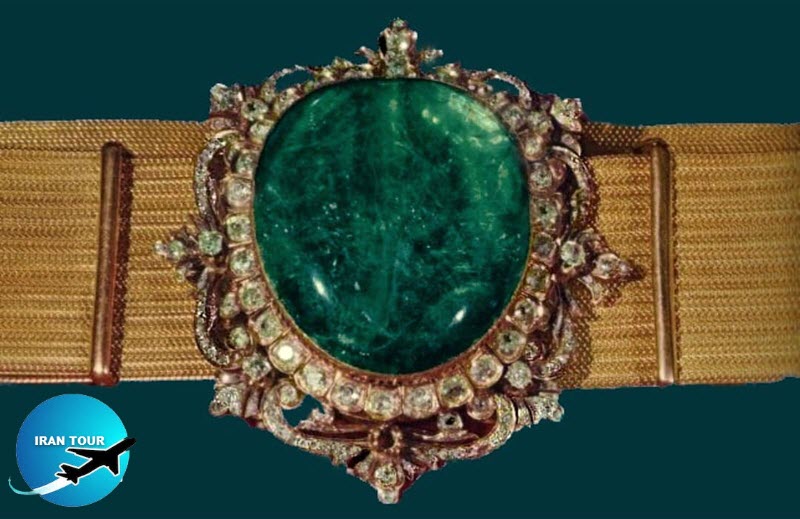 |
A golden belt with a large emerald
A golden belt with a large emerald of 175.5 carats set in the buckle, surrounded by 60 brilliant-cut diamonds and 145 rose-cut diamonds. Its total length is 119 centimeters and the width is 4 centimeters. There are clasps for adjusting the belt. It was used in the coronation of Reza Khan Pahlavi in 1926 AD, and with a slight adjustment, re-used in the coronation of Mohammad Reza Pahlavi in 1967 AD.
The Nadir Aigrette is set with diamonds and emeralds. The central emerald is cabochon and of
The royal scepter made of gold and diamonds was presented by the people of Azerbaijan in the coronation held on April 25, 1926 AD. This scepter measures 79 centimeters long. At the top of the scepter is a globe marked with geographic designs bearing the names of the continents. Three lions and suns support a diamond-studded crown with their right paws. The scepter bears certain verses from the Koran, as well as laudatory verses in praise of Reza Khan Pahlavi.
Made in Tabriz, 1925 AD. A pair of epaulets made of gold thread and each of them mounted with 2 large emeralds. Made in 1967 AD, for the coronation of Mohammad Reza Pahlavi.
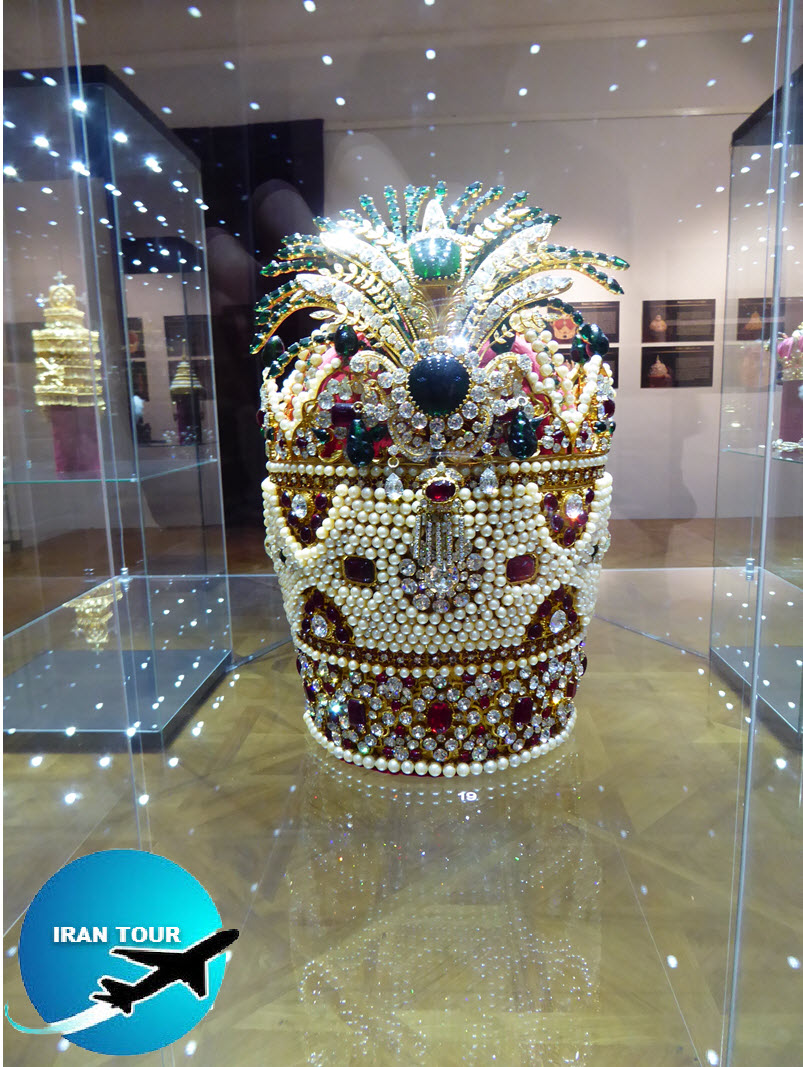 |
Fath-Ali Shah Qajar Crown
The Crown of Fath-Ali Shah Qajar is known as the "Kiani Crown" and set with diamonds, emeralds, rubies, and pearls. The final red stone is
Globe of Jewels
This Globe of Jewels was made in 1869 AD by order of Nasser-ed-din Shah. A group of Iranian craftsmen, under the supervision of Ebrahim Massihi, made this globe using the loose stones of the Treasury. The net gold used in this Globe is 34.00 kilograms and the total weight of the stones is 3,656 grams. The total number of stones used is 51,366 pieces. Finding the different countries can be difficult among the sparkle of the gems because the skill of the craftsmen was more in jewelry making than in geography. The oceans and seas are identified in emeralds and lands are shown in rubies. Southeast Asia, Iran, England,
 |
Peacock Throne
(Sun Throne ) During the reign of Fath-Ali Shah and by his order, a great throne was made under the supervision of Nezamoldoleh Mohammad Hossein Khan Sadr Esfahani, the governor of Isfahan, using gold and the loose stones of the treasury. (Early 19th century). As a design of sun encrusted with precious stones was used at the top of the throne, it became famous as the "Sun Throne". After the marriage of Fath-Ali Shah with Tavous* Tajodoleh, due to her name, the throne was named "Peacock Throne". Some Iranians thought that the above throne was the same brought from India but according to the definition of Tavernier from "Peacock Throne" and their own gatherings they came to the conclusion that it can not be the genuine "Peacock Throne." In order to confirm this view, they discussed the matter with Nasser-ed-din Shah and at last, became sure that this "Peacock Throne" was constructed by the order of Fath-Ali Shah and was named after his favorite wife Tavous Khanoum or Lady Peacock as "Peacock Throne".
After the death of Fath-Ali Shah and some years later, as Nasser-ed-din Shah loved jewels, ordered to repair of the throne by making some small changes in it. Therefore, some panels were added to the throne, depicting verses that confirm the repairment of the throne by Nasser-ed-din Shah. The verses are in blue enamel on a golden background. The verses are arranged very regularly and reveal the fact that they are added to the throne during its repair. The peacock throne was kept in Golestan Palace until 1360 (1981 AD). On 17/6/1360 (6th September 1981) the throne was delivered to the Treasury of the National Jewels located in the Central Bank of the Islamic Republic of Iran, to be kept in a place that it has similarity with the other pieces of the collection due to its rich accumulation of jewels. (Subject of the law approved in 1316 1927 AD) Cultural and Public Relations Management,
- Details
- Category: IRAN Blog